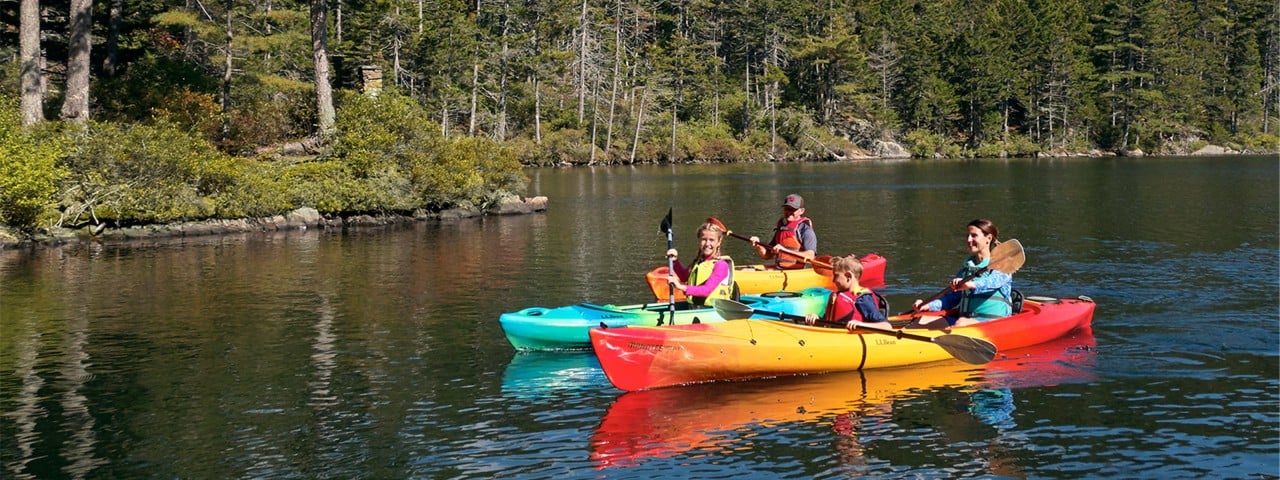
More people are kayaking than ever before, but this popular water sport is more than putting paddle to water. Now, thanks to the advice of our Outdoor Discovery Programs paddling pros, we’re passing that insider info on to you. We hope they make your days on the water as relaxing and rewarding as can be.
Before we launch: be sure to always wear a PFD when on the water (safety first!) and check with your state to see if kayak registration is required. All set? Let’s dive in!
1. Don't stow it. Stick it!
There are some items you’ll want to have easy access to throughout the day. Whether it’s lip balm, sunscreen, or a granola bar (or two), a few strips of Velcro®-fastener under the hull of your kayak can keep these items secure and out of the way, yet within reach while you’re out on the water. Attach the items directly or use plastic kitchen containers with clip-lock lids for water-sensitive gear like food, phones, cameras and keys.
2. Create some DIY dry storage.
A standard 32-ounce Nalgene water bottle is a great storage solution for small items you want to keep dry. Before you head out, pack it with things like personal medications, adhesive bandages, a small headlamp, and whatever you want close at hand. Not only are these bottles watertight when properly sealed, most are transparent (so you can easily see what’s inside) – and they float!
3. Make use of nature’s refrigerator.
You don’t always have to haul a hefty cooler around to keep food and drinks cold while kayaking. If you’re paddling in a place where the water is cold, storing food at the bottom of your kayak (in a watertight dry bag or container) will work just as well. The chill from the water will keep your lunchtime treats fresh and your stomach happy when it’s time to chow down.
4. Give your legs a rest.
Space is at a premium in most kayaks, so if you’re out for a long paddle, there’s a good chance your legs will start to feel a bit cramped. One way to find relief is to let your dry bag do double duty: place it underneath your knees to use as a leg pillow and enjoy some extra comfort. As a bonus, you’ll also open up some space in your hull or hatch for other important gear.
5. Don’t leave home without foam.
A small piece of foam (approximately 2' x 2') is like a Swiss Army knife for kayakers. You can tuck it behind your seat for extra padding, use it to sit on rocks when taking a lunch break, or kneel on it if you need to make adjustments or fix something on your kayak. It also comes in handy for protecting your car when loading and unloading your boat. Our experts recommend using closed-cell foam (like the kind commonly used for non-inflating sleeping pads), as it won’t absorb water.
6. Secure your kayak the smart way.
Many experienced kayakers put at least two non-aluminum carabiners and approximately six to eight feet of paracord or rope (called a “painter”) on their packing list. When tied off to the bow of your boat, this crafty combo gives you a quick way to moor to a dock cleat or tree while you’re taking a break. By integrating a carabiner, you can secure and release your kayak in a snap, so you won’t waste any quality paddling time.
7. A brilliant way to bail out.
From time to time, you’ll get water inside your kayak while paddling. In fact, it’s pretty much inevitable. And while it’s usually not cause for concern, it could get any gear stored in your hull wet. The unexpected fix? Carry a sponge with you as a way to sop up the water, then squeeze it out over the side where it belongs.
8. Use your noodle to make gear float.
Have something you want to make sure will float if it goes overboard? Cut a length of pool noodle and create a slit along its length to expose the center. Now you can wrap the noodle around items like the lanyard of your sunglasses or a paddle leash. Add a few zip ties around the noodle to hold it in place. You might want to do a test to make sure there’s enough noodle to float your item before heading to the open water.
9. Prepare for sunny reflections.
Most people know to protect themselves from sunlight shining down on them, but when you’re on the water, it’s equally as important to protect yourself from sunlight being reflected up. A combination of protective clothing and sunscreen applied to areas you may not normally think about, such as the backs of your arms, underneath your nose and chin, and even the inside of your ears, is the best way to make sure you don’t get burned.
10. Take a course to learn even more.
When you sign up for one of our Outdoor Discovery Programs kayaking courses, you’ll head out on the water with experts just like the ones who contributed to this article. It’s the best way to see some of these hacks in action, learn even more tips and tricks, and take home other important skills like navigation, safety and paddling technique.


